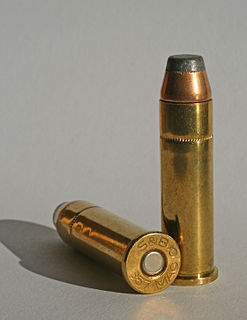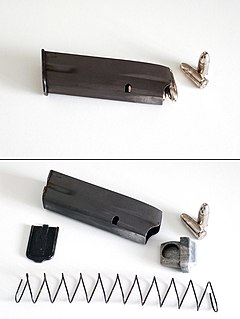
A firearm is any type of gun designed to be readily carried and used by an individual. The term is legally defined further in different countries.

A cartridge or a round is a type of pre-assembled firearm ammunition packaging a projectile, a propellant substance and an ignition device (primer) within a metallic, paper, or plastic case that is precisely made to fit within the barrel chamber of a breechloading gun, for the practical purpose of convenient transportation and handling during shooting. Although in popular usage the term "bullet" is often informally used to refer to a complete cartridge, it is correctly used only to refer to the projectile.

The .50 Browning Machine Gun is a .50 in (12.7 mm) caliber cartridge developed for the M2 Browning machine gun in the late 1910s, entering official service in 1921. Under STANAG 4383, it is a standard service cartridge for NATO forces as well as many non-NATO countries. The cartridge itself has been made in many variants: multiple generations of regular ball, tracer, armor-piercing (AP), incendiary, and saboted sub-caliber rounds. The rounds intended for machine guns are made into a continuous belt using metallic links.

A centerfire cartridge is a firearm metallic cartridge whose primer is located at the center of the base of its casing. Unlike rimfire cartridges, the centerfire primer is typically a separate component seated into a recessed cavity in the case head, and is replaceable by reloading.

Rimfire ammunition is a type of firearm metallic cartridge whose primer is located within a hollow circumferential rim protruding from the base of its casing. When fired, the gun's firing pin will strike and crush the rim against the edge of the barrel breech, sparking the primer compound within the rim, and in turn ignite the propellant within the case. Invented in 1845, by Louis-Nicolas Flobert, the first rimfire metallic cartridge was the .22 BB Cap cartridge, which consisted of a percussion cap with a bullet attached to the top. While many other different cartridge priming methods have been tried since the 19th century, only rimfire and the later centerfire cartridges survive to the present day with regular usages. The .22 Long Rifle rimfire cartridge, introduced in 1887, is by far the most common ammunition in the world today in terms of units sold.

A breechloader is a firearm in which the user loads the ammunition via the rear (breech) end of its barrel, as opposed to a muzzleloader, which loads ammunition via the front (muzzle).

A magazine is an ammunition storage and feeding device for a repeating firearm, either integral within the gun or externally attached. The magazine functions by holding several cartridges within itself and sequentially pushing each one into a position where it may be readily loaded into the barrel chamber by the firearm's moving action. The detachable magazine is sometimes colloquially referred to as a "clip", although this is technically inaccurate since a clip is actually an accessory device used to help loading ammunitions into a magazine.
The Sporting Arms and Ammunition Manufacturers' Institute is an association of American manufacturers of firearms, ammunition, and components. SAAMI is an accredited standards developer that publishes several American National Standards that provide safety, reliability, and interchangeability standards for commercial manufacturers of firearms, ammunition, and components. In addition, SAAMI publishes information on the safe and responsible transportation, storage, and use of those products.

In firearms, headspace is the distance measured from a closed chamber's breech face to the chamber feature that limits the insertion depth of a cartridge placed in it. Used as a verb by firearms designers, headspacing refers to the act of stopping deeper cartridge insertion. The exact part of the cartridge that seats against the limiting chamber feature differs among cartridge and gun designs. Bottleneck rifle cartridges headspace on their case shoulders; rimmed cartridges headspace on the forward surfaces of their case rims; belted cartridges headspace on the forward surfaces of their case belts; rimless pistol cartridges headspace on their case mouths.

A wildcat cartridge, often shortened to wildcat, is a custom cartridge for which ammunition and/or firearms are not mass-produced. These cartridges are often created in order to optimize a certain performance characteristic of an existing commercial cartridge.
The overall length (OAL) of an ammunition cartridge is a measurement from the base of the brass shell casing to the tip of the bullet, seated into the brass casing. Cartridge overall length, or "COL", is important to safe functioning of reloads in firearms.

The 6.5×55mm Swedish is a first-generation smokeless powder rimless bottlenecked rifle cartridge. It was introduced in the 1890s, and is still one of the most common cartridges in modern rifles built for the Scandinavian market today. The cartridge was developed in a joint Norwegian and Swedish effort starting in 1891 for use in the new service rifles then under consideration by the United Kingdoms of Sweden and Norway. In 1893, the cartridge was standardized and adopted under the name 6.5×55mm to facilitate logistical cooperation between Norway and Sweden. The two nations had independent armies and consequently the normal procedure at the time was for their respective governments to use the same ammunition and then purchase small arms of their choice. Norway adopted the Krag–Jørgensen M/1894 rifle, while Sweden adopted the Mauser m/1896 rifle design that was based on a Mauser service rifle designed around the 7×57mm Mauser cartridge.
Hornady Manufacturing Company is an American manufacturer of ammunition and handloading components, based in Grand Island, Nebraska.
The .222 Remington Magnum was a short-lived commercially produced cartridge derived from the .222 Remington. Originally developed for a US military prototype Armalite AR-15 rifle in 1958, the cartridge was not adopted by the military, but was introduced commercially in sporting rifles.

The Commission internationale permanente pour l'épreuve des armes à feu portatives is an international organisation which sets standards for safety testing of firearms. As of 2015, its members are the national governments of 14 countries, of which 11 are European Union member states. The C.I.P. safeguards that all firearms and ammunition sold to civilian purchasers in member states are safe for the users.

NATO EPVAT testing is one of the three recognized classes of procedures used in the world to control the safety and quality of firearms ammunition.

Ammunition is the material fired, scattered, dropped or detonated from any weapon or weapon system. Ammunition is both expendable weapons and the component parts of other weapons that create the effect on a target. Nearly all mechanical weapons require some form of ammunition to operate.

The FN 5.7×28mm (designated as the 5.7×28 by the C.I.P. and FN 5.7x28mm NATO) is a small-caliber, high-velocity, smokeless powder, rebated rim, bottlenecked centerfire cartridge designed for handgun and personal defense weapon (PDW) uses manufactured by FN Herstal. It is similar in length to the .22 WMR (5.7×27mm) and to some degree similar also to the .22 Hornet or .22 K-Hornet. Unlike many new cartridges, it has no parent case; the complete package was developed from scratch by FN.
The German Experimental and Test Institute for Hunting and Sporting Firearms, usually shortened DEVA, is a German manufacturer's association whose purpose is to provide independent advice and testing for firearms and ammunition. DEVA conducts its work independently, and is co-owned by most German firearm manufacturers, such as Blaser, Heckler & Koch, Heym, Mauser, Merkel, Sauer, etc. DEVA today consists of two branches, one in Dune, Altenbeken and one on Stahnsdorfer Damm, Berlin.
European Cartridge Research Association (ECRA) is a nonprofit organization which aims to promote interest and knowledge about ammunition of all types and forms. The organization was founded in 1965 under the name European Cartridge Collectors Club by the Belgian Emile Timmermans, and later changed name to the European Cartridge Research Association. While ECRA consists of European member associations, it also has individual members from outside Europe.













